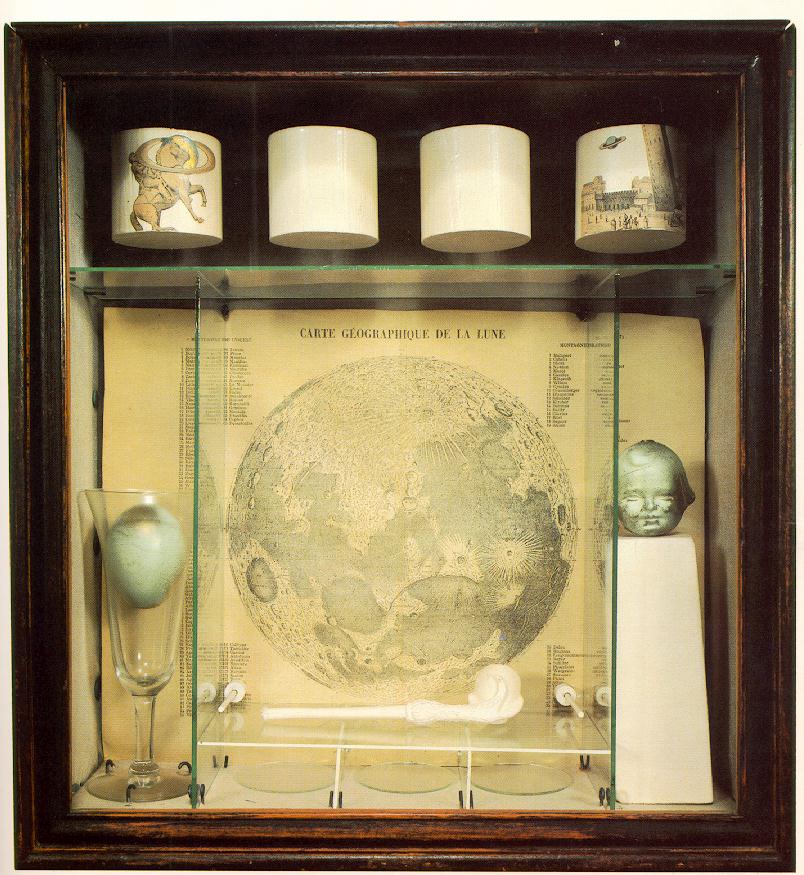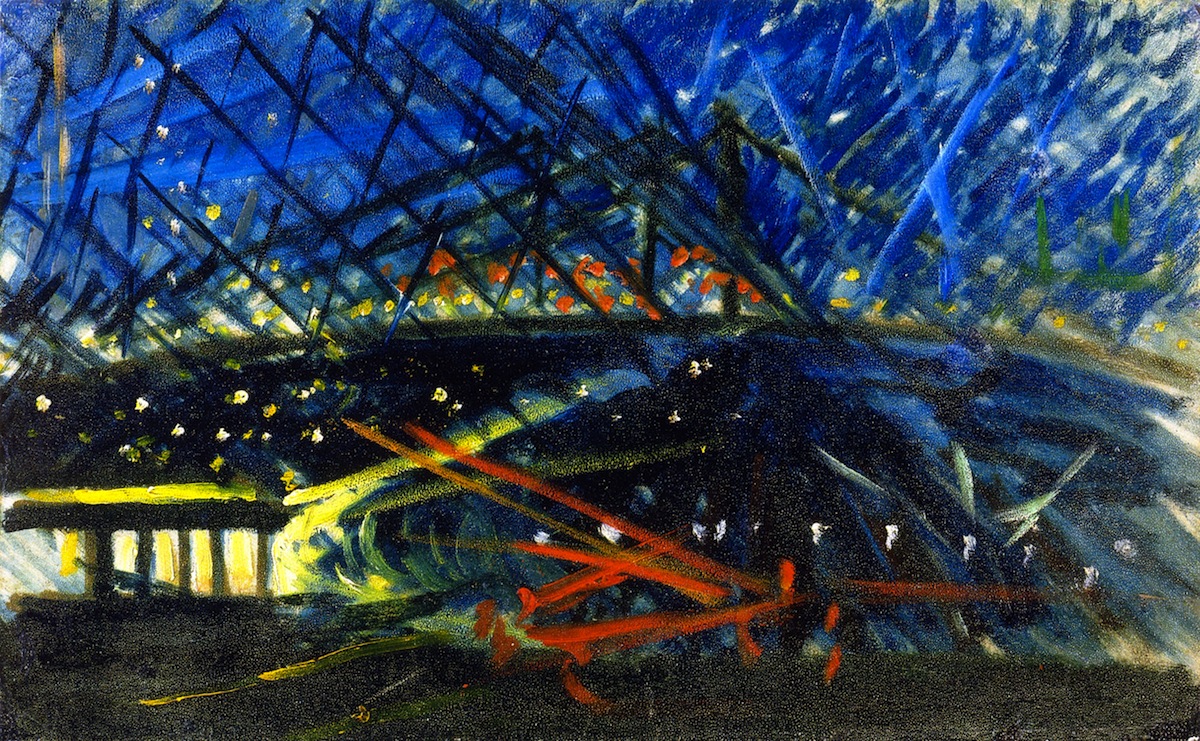- The Watermelon Race (1930) by Palmer Hayden
-

The Watermelon Race by Palmer Hayden
- Palmer Hayden, whose original name was Peyton Cole Hedgeman, was born on January 15, 1890 in Widewater Virginia (“Palmer Hayden”). During the Harlem Renaissance, he migrated to New York City, hoping to become a part of the movement. One of the core ideas of the Harlem Renaissance was to spread Black culture through artistic expressions. At the time, African Americans were still disenfranchised and heavily discriminated against. There were numerous racial stereotypes targeted towards black communities, with the most prominent ones classifying all Black people as “watermelon eaters” with huge lips. Instead of avoiding these stereotypes, Hayden proudly depicted these stereotypes in his paintings. The Watermelon Race (1890) was a perfect example of that as it highlights these stereotypes by exaggerating their facial constructs and their intense desire for watermelon.
-
- The Painter Who Paints (1930) by Palmer Hayden
-

The Painter Who Paints by Palmer Hayden
- Throughout the Harlem Renaissance, African Americans were often viewed as the lower class of society, despite their education and talents. A fellow African American and the friend of Palmer Hayden, Cloyd Boykin, was one of the many who faced such discrimination. Despite Boykin’s artistic talents, he was criticized and undermined due to his race (The Janitor Who Paints). This racist sentiment that undermined Black Excellence denounced both Hayden’s beliefs and the core values of the Harlem Renaissance. As such, Hayden creates a masterpiece that I believe is the cornerstone of the Harlem Renaissance. In The Painter Who Paints (1930), he was able to kill two birds with one stone. First, he challenged the common belief at the time that African Americans were talentless. Second, he incorporated the exaggerated facial expressions in the characters, a style that was emblematic to his works. Through this painting, he confronted the African American stereotypes prevalent at the time.
-
- How the Other Half Lives by Jacob Riis
- https://www.gutenberg.org/files/45502/45502-h/45502-h.htm
- Jacob Riis was a Danish immigrant who immigrated to the United States in 1870 in search of better career opportunities (“Jacob Riis”). He pursued a career as a carpenter for a few years, but soon became a police reporter. This job naturally allowed him to uncover the secrets of the streets of New York. As he investigated, he discovered the harsh living conditions in the slums of the Lower East Side. In 2890, he decided to take action and published a photojournal known as How the Other Half Lives, which exposed the unsafe and overcrowded living conditions in the tenements. He described the living quarters in the tenements to be “so small that [he] was unable to get a photograph of it even by placing the camera outside the open door” (Riis 12). As his work gained popularity, the middle and upper class began realizing “how the other half lives”. This realization sparked a series of urban reforms, including the Tenement House Act of 1901, which set strict standards for sanitation, spacing, and safety in the tenements.
- Scarface (1983) written by Oliver Stone
- Oliver Stone is an American film writer who won multiple prestigious awards, including the Golden Globe Award and Oscar, both for the Best Director (“Oliver Stone Awards”). One of his early and critically acclaimed film, Scarface (1983), received tremendous success. The film revolves around an aspiring criminal known as Tony Montana. Upon immigrating to the United States, he quickly joins the Frank Lopez’s drug business. As he climbs the ranks and gains power, his conscience is slowly consumed by the overwhelming desire for wealth and success. He eventually takes over the business and gains control of the drug trade between North and South America. His ultimate downfall was a result of the overwhelming greed that dictated his actions. What made this movie so successful was the irresistible force of greed that lurks in every corner of the film, giving the audience a taste of the immense power and success portrayed in the film. I would nominate this film as the greatest film of the crime and gangster genre.
- Wall Street (1987) directed by Oliver Stone
- While Scarface (1983) was critically acclaimed for the depiction of greed, Wall Street (1987) does not lag behind either. Like Tony Montana, Bud Fox abandoned his old life in search of greater success. Before quitting his old job as a salesman, he had a stable income of roughly $50,000, which was fairly high at the time. Instead, he decides to become a stockbroker and looks up to Gordon Gekko, one of the legendary Wall Street investors at the time. He blindly followed Gekko’s orders regardless of the ethics or legality of the situation, similar to the way Tony would kill for Frank. As he gets a taste of success, he falls victim to the boundless desire for wealth and success. Both Scarface (1983) and Wall Street (1987) succeeds in portraying greed as the central theme. What separates the two films is the setting, where Scarface is situated in a more delusional setting and Wall Street is established in an accurately portrayed setting representing New York City.
- Maggie: Girl of the Streets by Stephen Crane
- http://www.gutenberg.org/files/447/447-h/447-h.htm
- Crane’s heartbreaking novela depicted life in the slums. Maggie: Girl of the Streets shares many similarities with the work of Riis, where Riis exposed the poor living conditions in the Lower East Side and Crane explored the issue at a human interaction level rather than a societal level. To some extent, this was more powerful and impactful than the works of Riis as it developed a sense of intimacy between the novel’s characters and the audience. After reading the novel, I was able to further understand how the horrible living conditions in the slums was not only detrimental to their health and safety, but also their mental wellness. In multiple occasions, Maggie’s mother would verbally abuse her daughter, which arguably has led to her final demise.
- Soap Bubble Set by Joseph Cornell
-

Soap Bubble Set by Joseph Cornell
- Much of Cornell’s early life centered around his career as a salesman. However, as a result of the Great Depression, Cornell lost his job and began developing an interest for the arts, particularly the Surrealist art displayed at the Julien Levy Gallery (“Joseph Cornell”). He began developing this new style of art known as Assemblage, which differentiated himself from other Surrealists as he assembled real life objects into a box to create a three-dimensional artwork. One of his most famous works, the Soap Bubble Set, embodied the Surrealist style of combining juxtaposing elements while also incorporating his unique three-dimensional shadow box. Not only did extra layer of depth struck out to me by breaking the conventions of traditional “art”, but the everyday objects he used (like a glass and an egg) helped with my interpretation of the artwork without completely giving it away.
-
- Brooklyn Bridge 1941 by Joseph Stella
-

Brooklyn Bridge by Joseph Stella
- Joseph Stella’s paintings of Brooklyn Bridge was well-known for its futuristic and modern style. His projects had been pivotal to the Precisionist Movement in the 1920s, which combined Cubist as well as Futurist values. In this particular painting of Brooklyn Bridge by Joseph Stella, there is a overwhelming use of geometric shapes. The sharp and precise edges of this painting and the contrast provided by the plethora of colors give it futuristic appearance. In addition, he often used the white color to provide a metallic look on certain parts of the bridge, which also adds to the futuristic look. What makes this painting, and other works for that matter, special is how transformative this style was. The Brooklyn Bridge we see today is over a century old, yet Stella was able to transform this painting into something futuristic, even decades after it was painted.
-
- Night View Of Brooklyn Bridge (1918) by Joseph Stella
-

Night View of Brooklyn Bridge by Joseph Stella
- Despite coming from the same painter, this painting differs remarkably from his other works. As mentioned before, he used techniques from the Precisionists, who utilized geometric shapes to depict an industrial element. This painting, however, was different from his other works. From the color alone, this painting reminds me of Van Gogh’s Starry Night, which also used a night blue for the sky combined with various darker colors, all topped with a brightly golden-yellow light to provide contrast. Instead of circular brushstrokes or geometric shapes with sharp edges, this painting was using clean and straight strokes. Yet, it has this blurring effect to it that resembles Starry Night. This was very different from his later Precision style, where the paintings were sharp and geometric. While it doesn’t give off the futuristic look that I enjoy, the contrast of the colors mirror a grand spectacle in the middle of the night (imagine an opera performance under the night sky, where all the light is centered around the performance. This was the vibe this painting gave to me).
-
- Officer of the Hussars by Kehinde Wiley
-

Officer of the Hussar by Kehinde Wiley
- Like Palmer Hayden, Kehinde Wiley paints African American men in order to advocate for their place in society. What sets them apart, however, is that Hayden depicts African Americans through racial stereotypes that contradicts his beliefs while Wiley glorifies his fellow African Americans. In Officer of the Hussars, he puts an African American man on top of a white horse and leopard saddle, which symbolizes wealth and power. For a long time in history, powerful royalty sits on top of a white horse. Even today, that is the case. Yet, behind all that glory is a normal African American man with a tank top and Timberland shoes, which can be considered as overly casual compared to the horse and saddle. The message becomes clear that even a normal man can be glorified, specifically African Americans. By spreading this message, he is promoting Black Excellence. What I find beautiful about this painting, or all works of art, are the messages behind it. In this case, it is a powerful message embedded within a symbolic man on a horse.
-
Works Cited
“1901 Tenement House Act.” The Living City, www.tlcarchive.org/htm/framesets/themes
/tenements/fs_1901.htm. Accessed December 17, 2017.
“Oliver Stone Awards.” IMDb, http://www.imdb.com/name/nm0000231/awards. Accessed
December 18, 2017.
“Joseph Cornell.” Guggenheim, www.guggenheim.org/artwork/artist/joseph-cornell. Accessed
December 18, 2017.
“Palmer Hayden.” Encyclopedia Britannica. www.britannica.com/biography/Palmer-Hayden.
Accessed December 18, 2017
Hayden, Palmer. The Janitor Who Paints. Smithsonian American Art Museum.
americanart.si.edu/artwork/the-janitor-who-paints-10126. Accessed December 18, 2017
Hayden, Palmer. The Watermelon Race, invaluable.com.
www.invaluable.com/auction-lot/palmer-hayden-1890-1973-the-watermelon-race-7-c-i2nc8col3t. Accessed December 18, 2017
Riis, Jacob. How the Other Half Lives: Studies Among the Tenements of New York. Urbana,
Illinois: Project Gutenberg, 2014. www.gutenberg.org/files/45502/45502-h/45502-h.htm. Accessed December 18, 2017.


Leave a Reply
You must be logged in to post a comment.